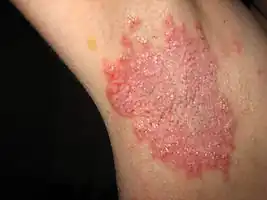Hailey–Hailey disease
| Hailey-Hailey disease | |
|---|---|
| Other names: Familial benign chronic pemphigus | |
.jpg.webp) | |
Hailey–Hailey disease, or familial benign chronic pemphigus or familial benign pemphigus, is a skin disease that presents with persistent and recurrent blisters, multiple cracks in the skin and inflammation around the side of the neck, underarms and inner sides of joints.[1]
It was originally described by the Hailey brothers (Hugh Edward and William Howard) in 1939.[2][3] It is a genetic disorder that causes blisters to form on the skin.
Signs and symptoms
HHD is characterized by outbreaks of rashes and blisters on the skin. Affected areas of skin undergo repeated blistering and inflammation, and may be painful to the touch. Areas where the skin folds, as well as the armpits, groin, neck, buttocks and under the breasts are most commonly affected. In addition to blistering, other symptoms which accompany HHD include acantholysis, erythema and hyperkeratosis.[4]

 Right armpit skin affected during Hailey-Hailey disease flare
Right armpit skin affected during Hailey-Hailey disease flare
Causes
The cause of the disease is a haploinsufficiency of the enzyme ATP2C1;[5] the ATP2C1 gene is located on chromosome 3, which encodes the protein hSPCA1. A mutation on one copy of the gene causes only half of this necessary protein to be made and the cells of the skin do not adhere together properly due to malformation of intercellular desmosomes, causing acantholysis, blisters and rashes. There is no known cure.
Diagnosis
Classification
While the term pemphigus typically refers to "a rare group of blistering autoimmune diseases" affecting "the skin and mucous membranes",[6] Hailey–Hailey disease is not an autoimmune disorder and there are no autoantibodies.[7] According to Pemphigus Pemphigoid Foundation (IPPF), "familial benign chronic pemphigus, or Hailey-Hailey disease, is a different condition from Pemphigus".[8]
Differential diagnosis
The differential diagnosis includes intertrigo, candidiasis, frictional or contact dermatitis, and inverse psoriasis. A biopsy and/or family history can confirm. The lack of oral lesions and intercellular antibodies distinguishes familial benign pemphigus from other forms of pemphigus.
Treatment
Topical steroid preparations often help outbreaks; use of the weakest corticosteroid that is effective is recommended to help prevent thinning of the skin. Drugs such as antibiotics, antifungals, corticosteroids, dapsone, methotrexate, thalidomide, etretinate, cyclosporine and, most recently, intramuscular alefacept may control the disease but are ineffective for severe chronic or relapsing forms of the disease. Intracutaneous injections of botulinum toxin to inhibit perspiration may be of benefit.[9] Maintaining a healthy weight, avoiding heat and friction of affected areas, and keeping the area clean and dry may help prevent flares.
Some have found relief in laser resurfacing that burns off the top layer of the epidermis, allowing healthy non-affected skin to regrow in its place.Secondary bacterial, fungal and/or viral infections are common and may exacerbate an outbreak. Some have found that outbreaks are triggered by certain foods, hormone cycles and stress.
In many cases naltrexone, taken daily in low doses, appears to help.[10][11]
See also
References
- ↑ James, William D.; Elston, Dirk; Treat, James R.; Rosenbach, Misha A.; Neuhaus, Isaac (2020). "27. Genodermatoses and congenital anomalies". Andrews' Diseases of the Skin: Clinical Dermatology (13th ed.). Edinburgh: Elsevier. p. 562. ISBN 978-0-323-54753-6. Archived from the original on 2022-04-19. Retrieved 2022-04-18.
- ↑ synd/2081 at Who Named It?
- ↑ H. Hailey, H. Hailey. Familial benign chronic pemphigus. Report of 13 cases in four generations of a family and report of 9 additional cases in 4 generations of a family. Archives of Dermatology and Syphilology, Chicago, 1939, 39: 679-685.
- ↑ "Hailey-Hailey disease | Genetic and Rare Diseases Information Center (GARD) – an NCATS Program". rarediseases.info.nih.gov. Archived from the original on 2021-03-18. Retrieved 2021-03-21.
- ↑ Hu Z, Bonifas JM, Beech J, et al. (January 2000). "Mutations in ATP2C1, encoding a calcium pump, cause Hailey-Hailey disease". Nat. Genet. 24 (1): 61–5. doi:10.1038/71701. PMID 10615129. S2CID 41274246.
- ↑ Yeh, S. W.; Ahmed, Babar; Sami, Naveed; Ahmed, A. Razzaque (September 2003). "Blistering disorders: diagnosis and treatment". Dermatologic Therapy. 16 (3): 214–223. doi:10.1046/j.1529-8019.2003.01631.x. PMID 14510878.
- ↑ Mauro, Theodora, MD. "Hailey-Hailey Disease". National Organization for Rare Disorders. Archived from the original on 16 January 2016. Retrieved 29 October 2015.
- ↑ "Pemphigus". Pemphigus Pemphigold Foundation. 2014-03-19. Archived from the original on 2019-12-07. Retrieved 29 October 2015.
- ↑ Carpenter, Teresa; Merchant, Farrukh (November 2008), "Familial benign pemphigus", Consultant, 48 (12), archived from the original on 2009-09-25, retrieved 2021-03-21
- ↑ Ibrahim O1, Hogan SR1, Vij A1, Fernandez AP2. Low-Dose Naltrexone Treatment of Familial Benign Pemphigus (Hailey-Hailey Disease). JAMA Dermatol. 2017 Aug 2. doi: 10.1001/jamadermatol.2017.2445.
- ↑ Albers LN, Arbiser JL, Feldman RJ. Treatment of Hailey-Hailey Disease With Low-Dose Naltrexone. JAMA Dermatol. 2017 Aug 2. doi: 10.1001/jamadermatol.2017.2446.
External links
| Classification |
|---|